LSCM802: Enhancing Customer Service Through Value Chain Management
VerifiedAdded on 2023/06/12
|13
|3371
|293
Essay
AI Summary
This essay examines the role of value chain management in achieving superior customer service, using Coca-Cola Company as a case study. It differentiates between supply chain and value chain management, highlighting the importance of collaboration within the supply chain for business survival in today's competitive market. The essay discusses Coca-Cola's value chain, including inbound logistics, operations, outbound logistics, marketing and sales, technology, procurement, and infrastructure, emphasizing the company's focus on technology, supplier relationships, and human resource development. It concludes that effective supply chain management is critical for businesses to meet heightened customer expectations in the era of globalization.
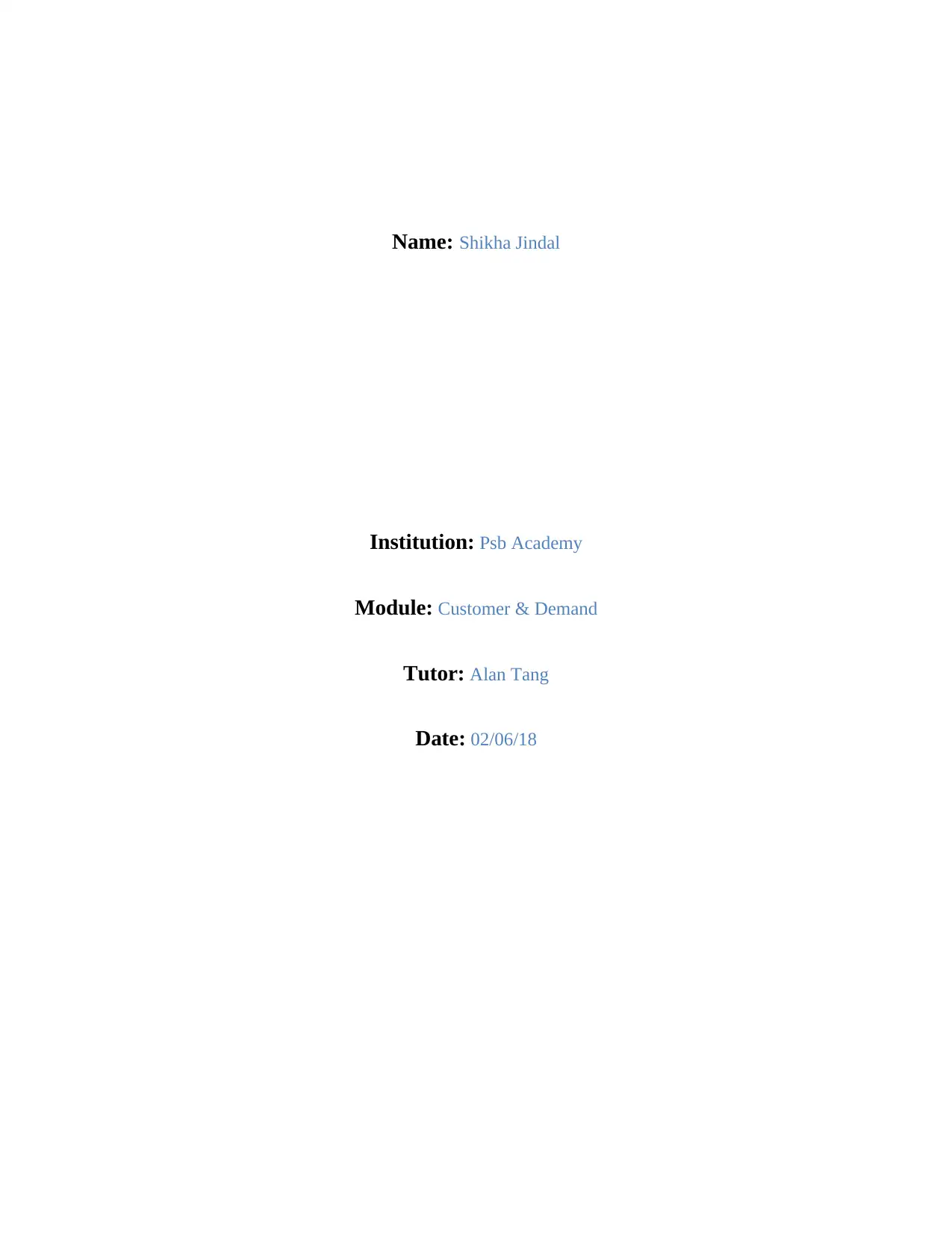
Name: Shikha Jindal
Institution: Psb Academy
Module: Customer & Demand
Tutor: Alan Tang
Date: 02/06/18
Institution: Psb Academy
Module: Customer & Demand
Tutor: Alan Tang
Date: 02/06/18
Paraphrase This Document
Need a fresh take? Get an instant paraphrase of this document with our AI Paraphraser
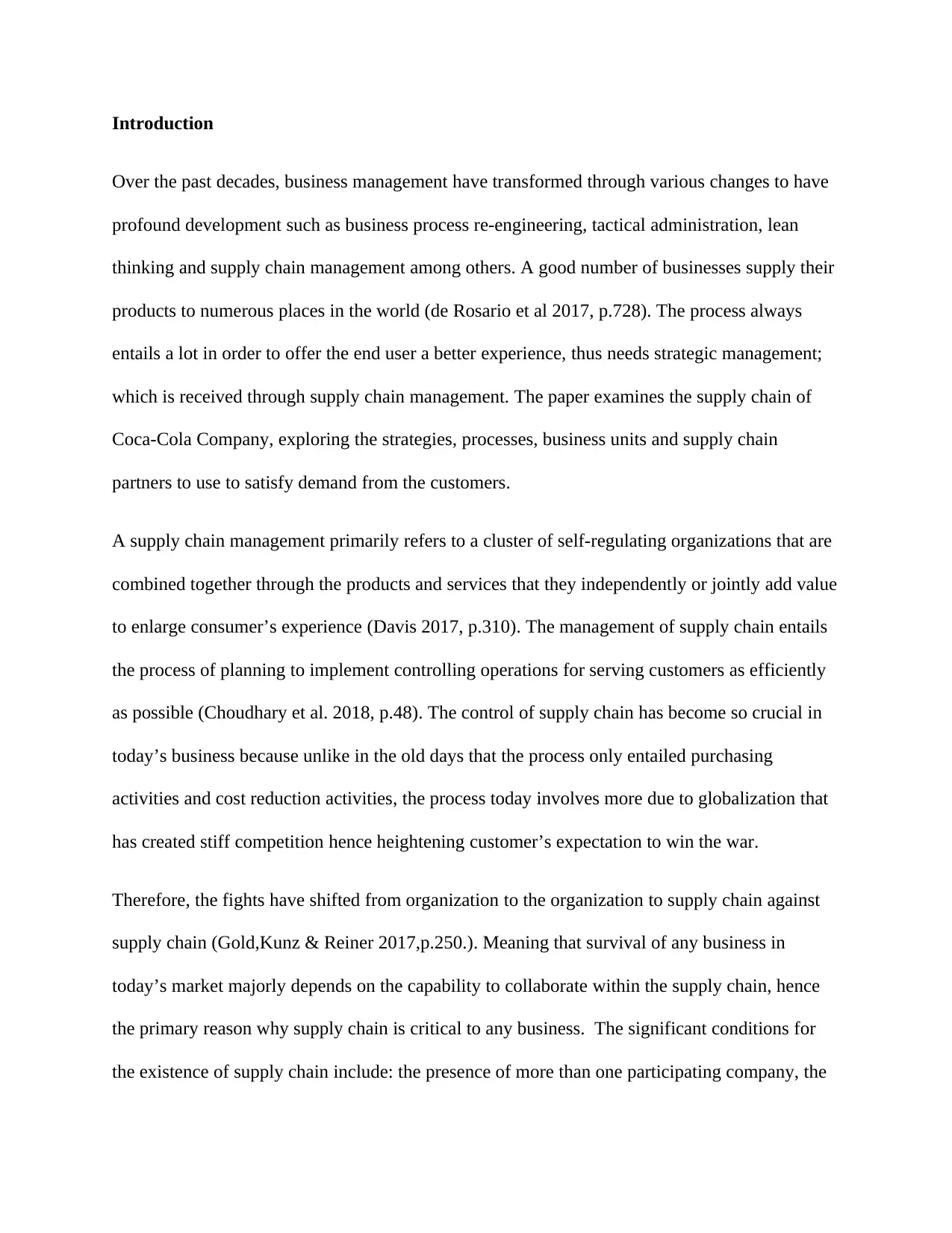
Introduction
Over the past decades, business management have transformed through various changes to have
profound development such as business process re-engineering, tactical administration, lean
thinking and supply chain management among others. A good number of businesses supply their
products to numerous places in the world (de Rosario et al 2017, p.728). The process always
entails a lot in order to offer the end user a better experience, thus needs strategic management;
which is received through supply chain management. The paper examines the supply chain of
Coca-Cola Company, exploring the strategies, processes, business units and supply chain
partners to use to satisfy demand from the customers.
A supply chain management primarily refers to a cluster of self-regulating organizations that are
combined together through the products and services that they independently or jointly add value
to enlarge consumer’s experience (Davis 2017, p.310). The management of supply chain entails
the process of planning to implement controlling operations for serving customers as efficiently
as possible (Choudhary et al. 2018, p.48). The control of supply chain has become so crucial in
today’s business because unlike in the old days that the process only entailed purchasing
activities and cost reduction activities, the process today involves more due to globalization that
has created stiff competition hence heightening customer’s expectation to win the war.
Therefore, the fights have shifted from organization to the organization to supply chain against
supply chain (Gold,Kunz & Reiner 2017,p.250.). Meaning that survival of any business in
today’s market majorly depends on the capability to collaborate within the supply chain, hence
the primary reason why supply chain is critical to any business. The significant conditions for
the existence of supply chain include: the presence of more than one participating company, the
Over the past decades, business management have transformed through various changes to have
profound development such as business process re-engineering, tactical administration, lean
thinking and supply chain management among others. A good number of businesses supply their
products to numerous places in the world (de Rosario et al 2017, p.728). The process always
entails a lot in order to offer the end user a better experience, thus needs strategic management;
which is received through supply chain management. The paper examines the supply chain of
Coca-Cola Company, exploring the strategies, processes, business units and supply chain
partners to use to satisfy demand from the customers.
A supply chain management primarily refers to a cluster of self-regulating organizations that are
combined together through the products and services that they independently or jointly add value
to enlarge consumer’s experience (Davis 2017, p.310). The management of supply chain entails
the process of planning to implement controlling operations for serving customers as efficiently
as possible (Choudhary et al. 2018, p.48). The control of supply chain has become so crucial in
today’s business because unlike in the old days that the process only entailed purchasing
activities and cost reduction activities, the process today involves more due to globalization that
has created stiff competition hence heightening customer’s expectation to win the war.
Therefore, the fights have shifted from organization to the organization to supply chain against
supply chain (Gold,Kunz & Reiner 2017,p.250.). Meaning that survival of any business in
today’s market majorly depends on the capability to collaborate within the supply chain, hence
the primary reason why supply chain is critical to any business. The significant conditions for
the existence of supply chain include: the presence of more than one participating company, the
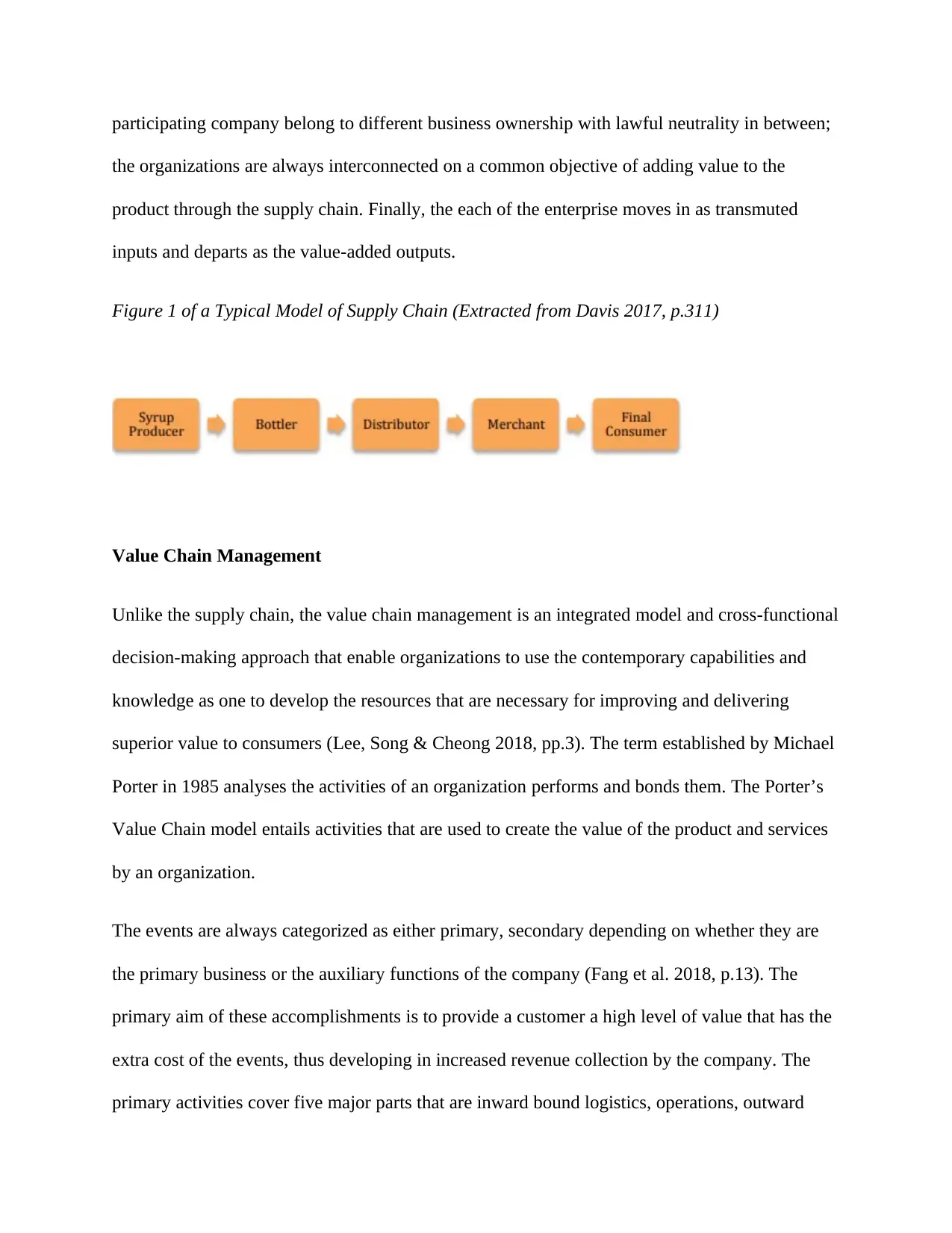
participating company belong to different business ownership with lawful neutrality in between;
the organizations are always interconnected on a common objective of adding value to the
product through the supply chain. Finally, the each of the enterprise moves in as transmuted
inputs and departs as the value-added outputs.
Figure 1 of a Typical Model of Supply Chain (Extracted from Davis 2017, p.311)
Value Chain Management
Unlike the supply chain, the value chain management is an integrated model and cross-functional
decision-making approach that enable organizations to use the contemporary capabilities and
knowledge as one to develop the resources that are necessary for improving and delivering
superior value to consumers (Lee, Song & Cheong 2018, pp.3). The term established by Michael
Porter in 1985 analyses the activities of an organization performs and bonds them. The Porter’s
Value Chain model entails activities that are used to create the value of the product and services
by an organization.
The events are always categorized as either primary, secondary depending on whether they are
the primary business or the auxiliary functions of the company (Fang et al. 2018, p.13). The
primary aim of these accomplishments is to provide a customer a high level of value that has the
extra cost of the events, thus developing in increased revenue collection by the company. The
primary activities cover five major parts that are inward bound logistics, operations, outward
the organizations are always interconnected on a common objective of adding value to the
product through the supply chain. Finally, the each of the enterprise moves in as transmuted
inputs and departs as the value-added outputs.
Figure 1 of a Typical Model of Supply Chain (Extracted from Davis 2017, p.311)
Value Chain Management
Unlike the supply chain, the value chain management is an integrated model and cross-functional
decision-making approach that enable organizations to use the contemporary capabilities and
knowledge as one to develop the resources that are necessary for improving and delivering
superior value to consumers (Lee, Song & Cheong 2018, pp.3). The term established by Michael
Porter in 1985 analyses the activities of an organization performs and bonds them. The Porter’s
Value Chain model entails activities that are used to create the value of the product and services
by an organization.
The events are always categorized as either primary, secondary depending on whether they are
the primary business or the auxiliary functions of the company (Fang et al. 2018, p.13). The
primary aim of these accomplishments is to provide a customer a high level of value that has the
extra cost of the events, thus developing in increased revenue collection by the company. The
primary activities cover five major parts that are inward bound logistics, operations, outward
⊘ This is a preview!⊘
Do you want full access?
Subscribe today to unlock all pages.

Trusted by 1+ million students worldwide
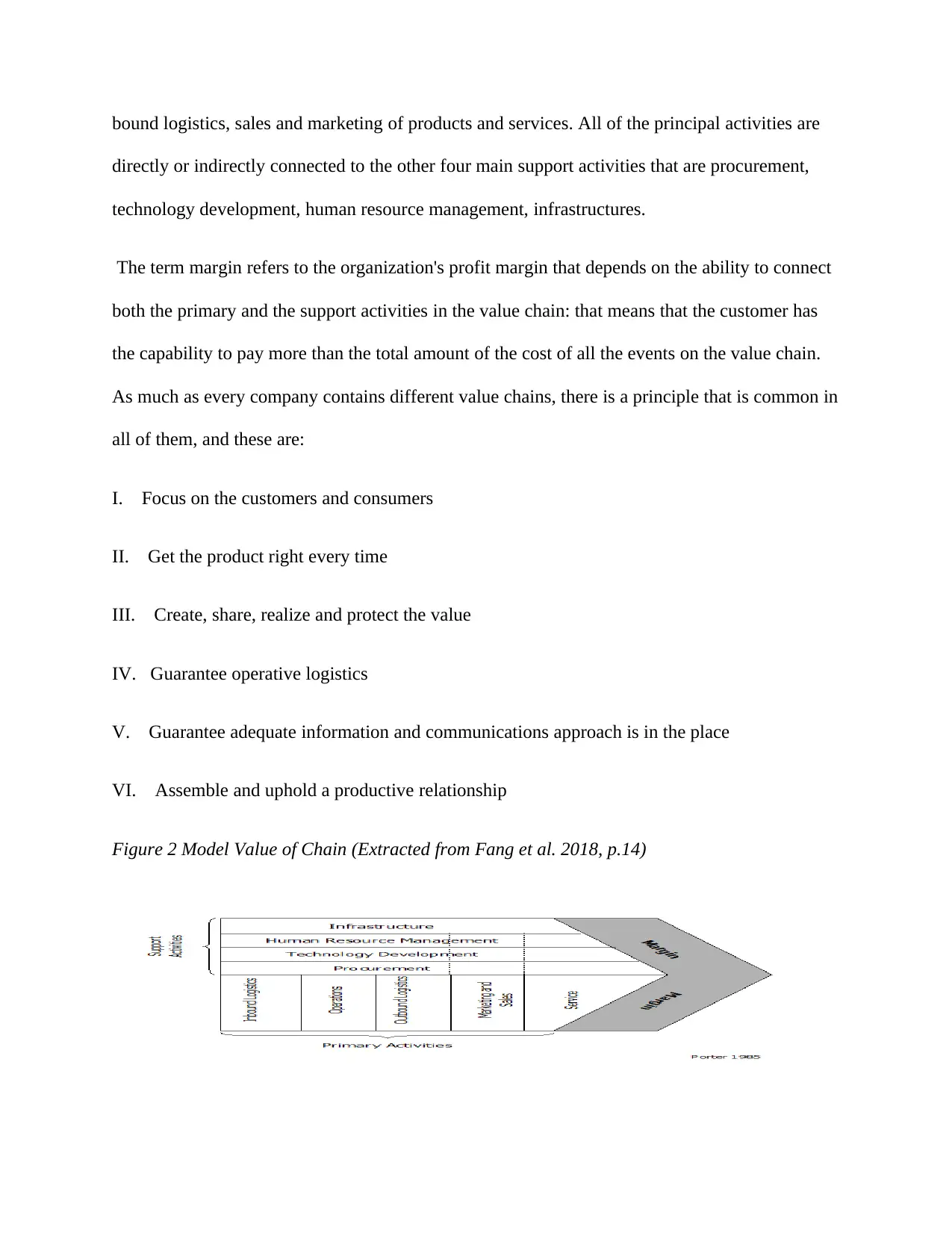
bound logistics, sales and marketing of products and services. All of the principal activities are
directly or indirectly connected to the other four main support activities that are procurement,
technology development, human resource management, infrastructures.
The term margin refers to the organization's profit margin that depends on the ability to connect
both the primary and the support activities in the value chain: that means that the customer has
the capability to pay more than the total amount of the cost of all the events on the value chain.
As much as every company contains different value chains, there is a principle that is common in
all of them, and these are:
I. Focus on the customers and consumers
II. Get the product right every time
III. Create, share, realize and protect the value
IV. Guarantee operative logistics
V. Guarantee adequate information and communications approach is in the place
VI. Assemble and uphold a productive relationship
Figure 2 Model Value of Chain (Extracted from Fang et al. 2018, p.14)
directly or indirectly connected to the other four main support activities that are procurement,
technology development, human resource management, infrastructures.
The term margin refers to the organization's profit margin that depends on the ability to connect
both the primary and the support activities in the value chain: that means that the customer has
the capability to pay more than the total amount of the cost of all the events on the value chain.
As much as every company contains different value chains, there is a principle that is common in
all of them, and these are:
I. Focus on the customers and consumers
II. Get the product right every time
III. Create, share, realize and protect the value
IV. Guarantee operative logistics
V. Guarantee adequate information and communications approach is in the place
VI. Assemble and uphold a productive relationship
Figure 2 Model Value of Chain (Extracted from Fang et al. 2018, p.14)
Paraphrase This Document
Need a fresh take? Get an instant paraphrase of this document with our AI Paraphraser
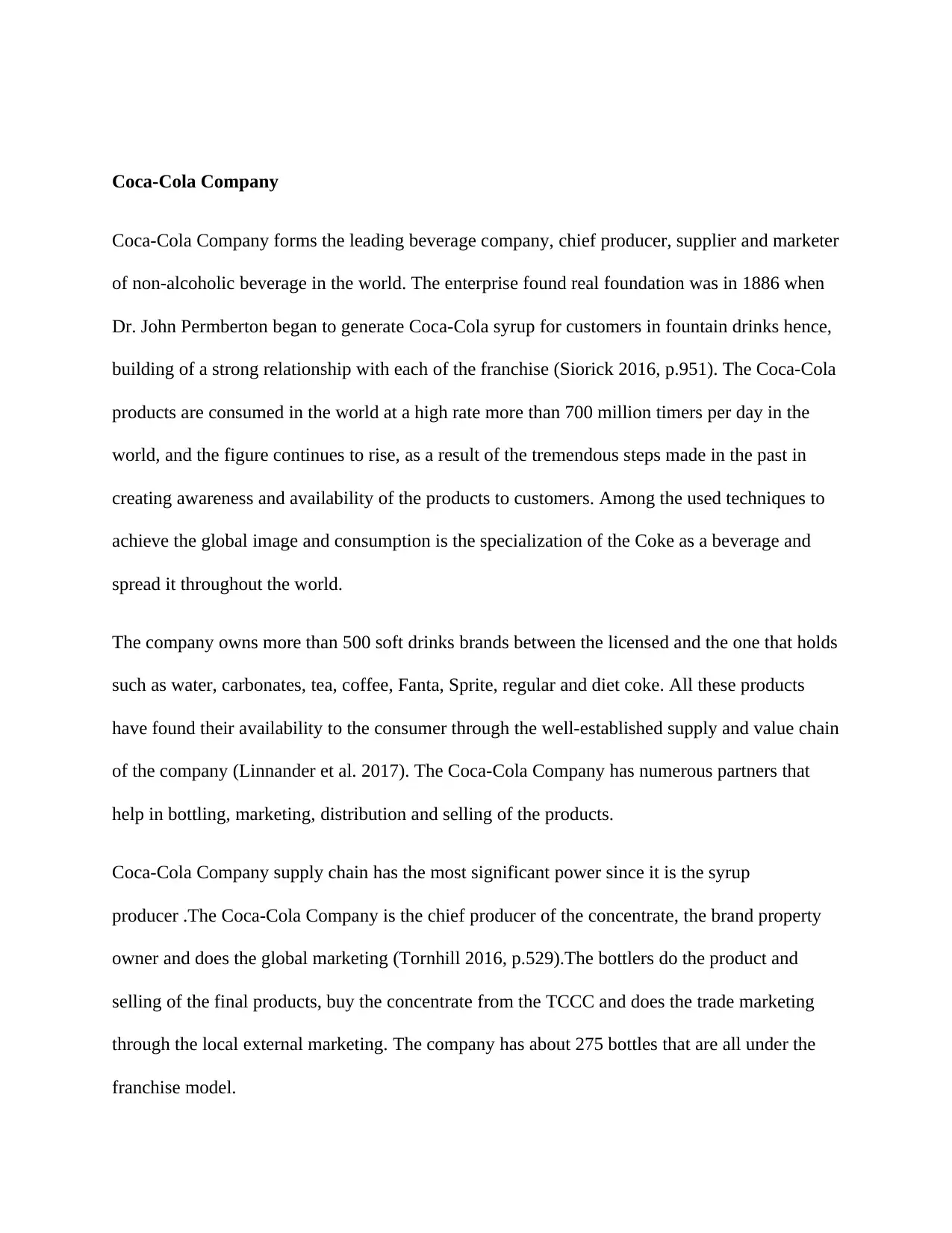
Coca-Cola Company
Coca-Cola Company forms the leading beverage company, chief producer, supplier and marketer
of non-alcoholic beverage in the world. The enterprise found real foundation was in 1886 when
Dr. John Permberton began to generate Coca-Cola syrup for customers in fountain drinks hence,
building of a strong relationship with each of the franchise (Siorick 2016, p.951). The Coca-Cola
products are consumed in the world at a high rate more than 700 million timers per day in the
world, and the figure continues to rise, as a result of the tremendous steps made in the past in
creating awareness and availability of the products to customers. Among the used techniques to
achieve the global image and consumption is the specialization of the Coke as a beverage and
spread it throughout the world.
The company owns more than 500 soft drinks brands between the licensed and the one that holds
such as water, carbonates, tea, coffee, Fanta, Sprite, regular and diet coke. All these products
have found their availability to the consumer through the well-established supply and value chain
of the company (Linnander et al. 2017). The Coca-Cola Company has numerous partners that
help in bottling, marketing, distribution and selling of the products.
Coca-Cola Company supply chain has the most significant power since it is the syrup
producer .The Coca-Cola Company is the chief producer of the concentrate, the brand property
owner and does the global marketing (Tornhill 2016, p.529).The bottlers do the product and
selling of the final products, buy the concentrate from the TCCC and does the trade marketing
through the local external marketing. The company has about 275 bottles that are all under the
franchise model.
Coca-Cola Company forms the leading beverage company, chief producer, supplier and marketer
of non-alcoholic beverage in the world. The enterprise found real foundation was in 1886 when
Dr. John Permberton began to generate Coca-Cola syrup for customers in fountain drinks hence,
building of a strong relationship with each of the franchise (Siorick 2016, p.951). The Coca-Cola
products are consumed in the world at a high rate more than 700 million timers per day in the
world, and the figure continues to rise, as a result of the tremendous steps made in the past in
creating awareness and availability of the products to customers. Among the used techniques to
achieve the global image and consumption is the specialization of the Coke as a beverage and
spread it throughout the world.
The company owns more than 500 soft drinks brands between the licensed and the one that holds
such as water, carbonates, tea, coffee, Fanta, Sprite, regular and diet coke. All these products
have found their availability to the consumer through the well-established supply and value chain
of the company (Linnander et al. 2017). The Coca-Cola Company has numerous partners that
help in bottling, marketing, distribution and selling of the products.
Coca-Cola Company supply chain has the most significant power since it is the syrup
producer .The Coca-Cola Company is the chief producer of the concentrate, the brand property
owner and does the global marketing (Tornhill 2016, p.529).The bottlers do the product and
selling of the final products, buy the concentrate from the TCCC and does the trade marketing
through the local external marketing. The company has about 275 bottles that are all under the
franchise model.
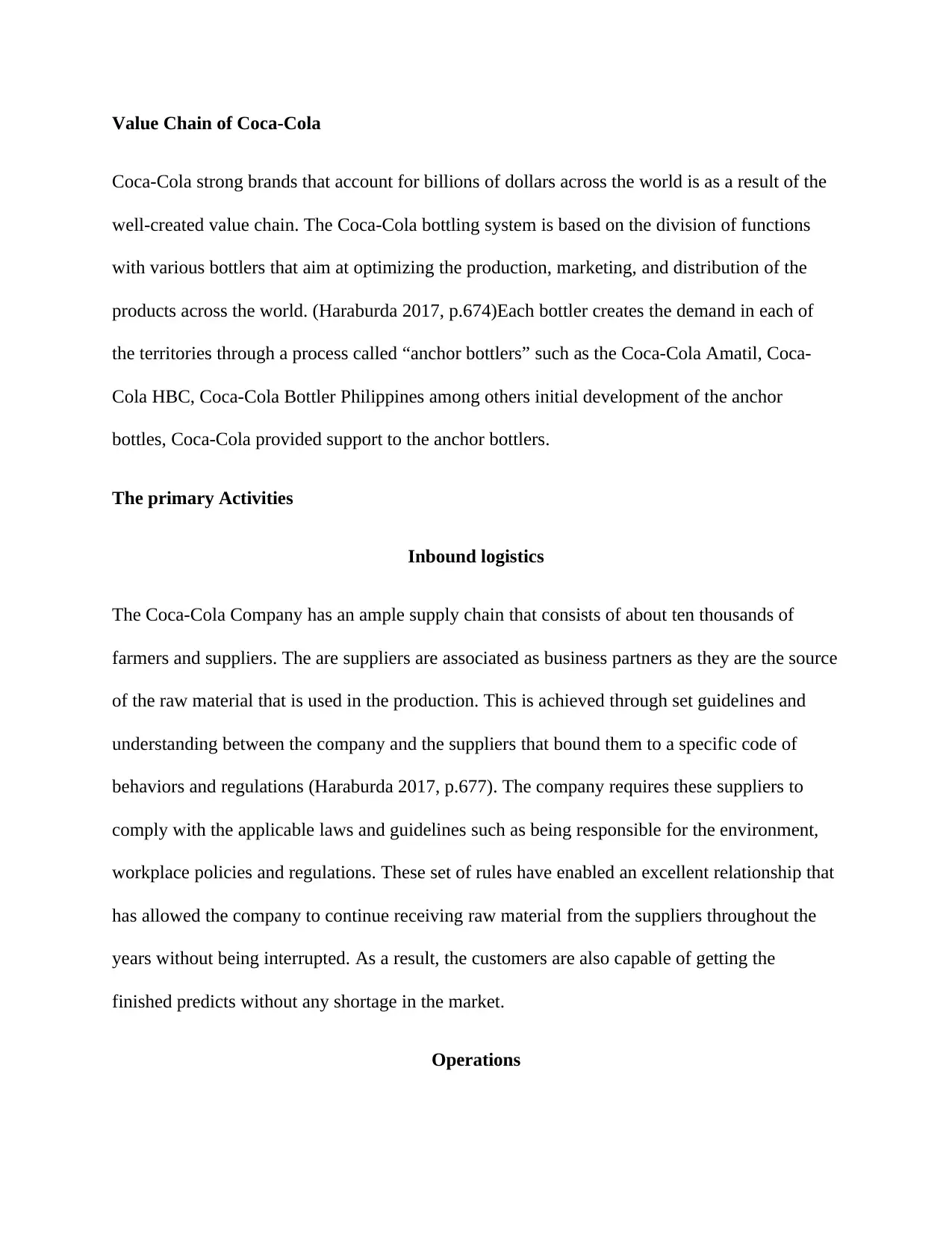
Value Chain of Coca-Cola
Coca-Cola strong brands that account for billions of dollars across the world is as a result of the
well-created value chain. The Coca-Cola bottling system is based on the division of functions
with various bottlers that aim at optimizing the production, marketing, and distribution of the
products across the world. (Haraburda 2017, p.674)Each bottler creates the demand in each of
the territories through a process called “anchor bottlers” such as the Coca-Cola Amatil, Coca-
Cola HBC, Coca-Cola Bottler Philippines among others initial development of the anchor
bottles, Coca-Cola provided support to the anchor bottlers.
The primary Activities
Inbound logistics
The Coca-Cola Company has an ample supply chain that consists of about ten thousands of
farmers and suppliers. The are suppliers are associated as business partners as they are the source
of the raw material that is used in the production. This is achieved through set guidelines and
understanding between the company and the suppliers that bound them to a specific code of
behaviors and regulations (Haraburda 2017, p.677). The company requires these suppliers to
comply with the applicable laws and guidelines such as being responsible for the environment,
workplace policies and regulations. These set of rules have enabled an excellent relationship that
has allowed the company to continue receiving raw material from the suppliers throughout the
years without being interrupted. As a result, the customers are also capable of getting the
finished predicts without any shortage in the market.
Operations
Coca-Cola strong brands that account for billions of dollars across the world is as a result of the
well-created value chain. The Coca-Cola bottling system is based on the division of functions
with various bottlers that aim at optimizing the production, marketing, and distribution of the
products across the world. (Haraburda 2017, p.674)Each bottler creates the demand in each of
the territories through a process called “anchor bottlers” such as the Coca-Cola Amatil, Coca-
Cola HBC, Coca-Cola Bottler Philippines among others initial development of the anchor
bottles, Coca-Cola provided support to the anchor bottlers.
The primary Activities
Inbound logistics
The Coca-Cola Company has an ample supply chain that consists of about ten thousands of
farmers and suppliers. The are suppliers are associated as business partners as they are the source
of the raw material that is used in the production. This is achieved through set guidelines and
understanding between the company and the suppliers that bound them to a specific code of
behaviors and regulations (Haraburda 2017, p.677). The company requires these suppliers to
comply with the applicable laws and guidelines such as being responsible for the environment,
workplace policies and regulations. These set of rules have enabled an excellent relationship that
has allowed the company to continue receiving raw material from the suppliers throughout the
years without being interrupted. As a result, the customers are also capable of getting the
finished predicts without any shortage in the market.
Operations
⊘ This is a preview!⊘
Do you want full access?
Subscribe today to unlock all pages.

Trusted by 1+ million students worldwide
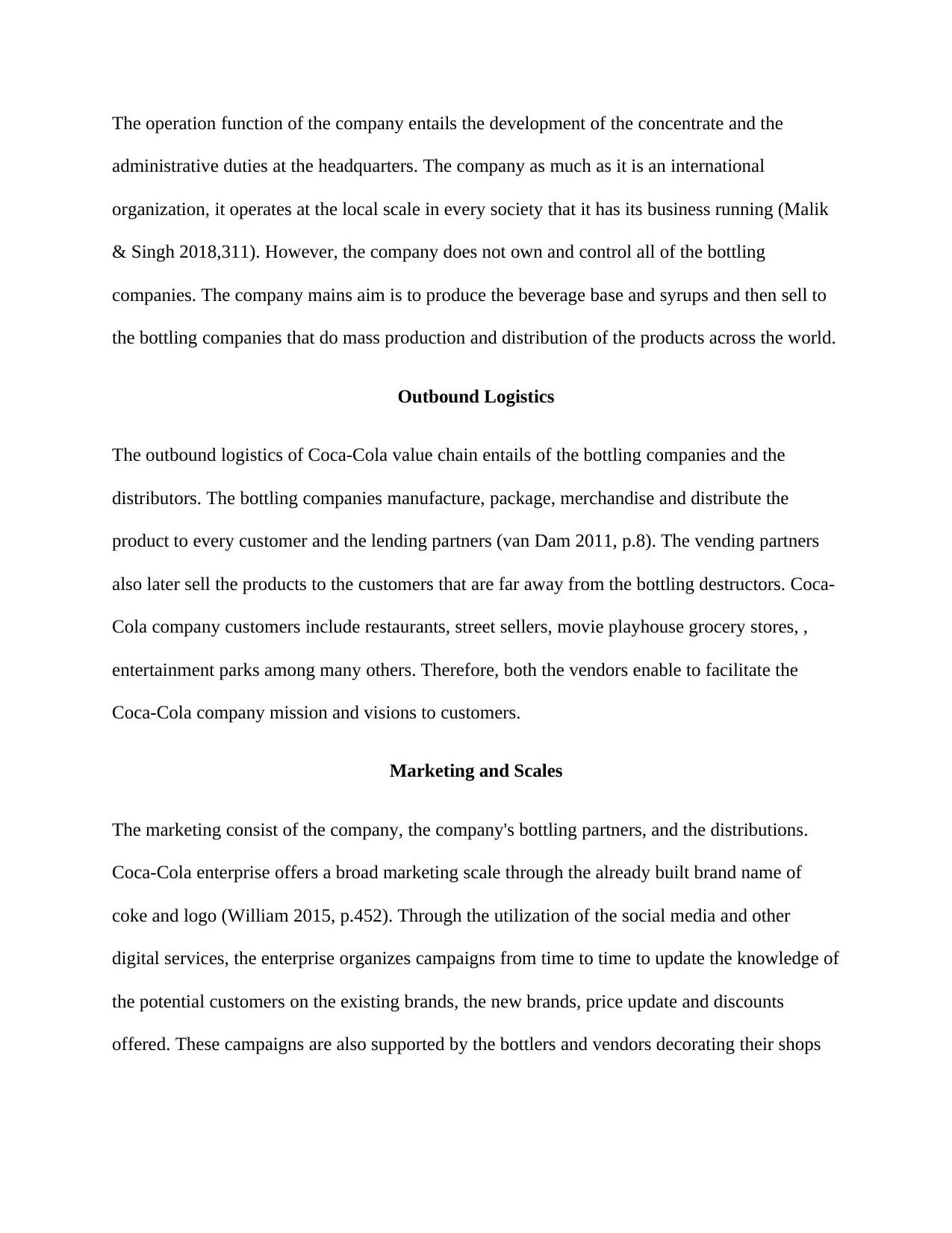
The operation function of the company entails the development of the concentrate and the
administrative duties at the headquarters. The company as much as it is an international
organization, it operates at the local scale in every society that it has its business running (Malik
& Singh 2018,311). However, the company does not own and control all of the bottling
companies. The company mains aim is to produce the beverage base and syrups and then sell to
the bottling companies that do mass production and distribution of the products across the world.
Outbound Logistics
The outbound logistics of Coca-Cola value chain entails of the bottling companies and the
distributors. The bottling companies manufacture, package, merchandise and distribute the
product to every customer and the lending partners (van Dam 2011, p.8). The vending partners
also later sell the products to the customers that are far away from the bottling destructors. Coca-
Cola company customers include restaurants, street sellers, movie playhouse grocery stores, ,
entertainment parks among many others. Therefore, both the vendors enable to facilitate the
Coca-Cola company mission and visions to customers.
Marketing and Scales
The marketing consist of the company, the company's bottling partners, and the distributions.
Coca-Cola enterprise offers a broad marketing scale through the already built brand name of
coke and logo (William 2015, p.452). Through the utilization of the social media and other
digital services, the enterprise organizes campaigns from time to time to update the knowledge of
the potential customers on the existing brands, the new brands, price update and discounts
offered. These campaigns are also supported by the bottlers and vendors decorating their shops
administrative duties at the headquarters. The company as much as it is an international
organization, it operates at the local scale in every society that it has its business running (Malik
& Singh 2018,311). However, the company does not own and control all of the bottling
companies. The company mains aim is to produce the beverage base and syrups and then sell to
the bottling companies that do mass production and distribution of the products across the world.
Outbound Logistics
The outbound logistics of Coca-Cola value chain entails of the bottling companies and the
distributors. The bottling companies manufacture, package, merchandise and distribute the
product to every customer and the lending partners (van Dam 2011, p.8). The vending partners
also later sell the products to the customers that are far away from the bottling destructors. Coca-
Cola company customers include restaurants, street sellers, movie playhouse grocery stores, ,
entertainment parks among many others. Therefore, both the vendors enable to facilitate the
Coca-Cola company mission and visions to customers.
Marketing and Scales
The marketing consist of the company, the company's bottling partners, and the distributions.
Coca-Cola enterprise offers a broad marketing scale through the already built brand name of
coke and logo (William 2015, p.452). Through the utilization of the social media and other
digital services, the enterprise organizes campaigns from time to time to update the knowledge of
the potential customers on the existing brands, the new brands, price update and discounts
offered. These campaigns are also supported by the bottlers and vendors decorating their shops
Paraphrase This Document
Need a fresh take? Get an instant paraphrase of this document with our AI Paraphraser
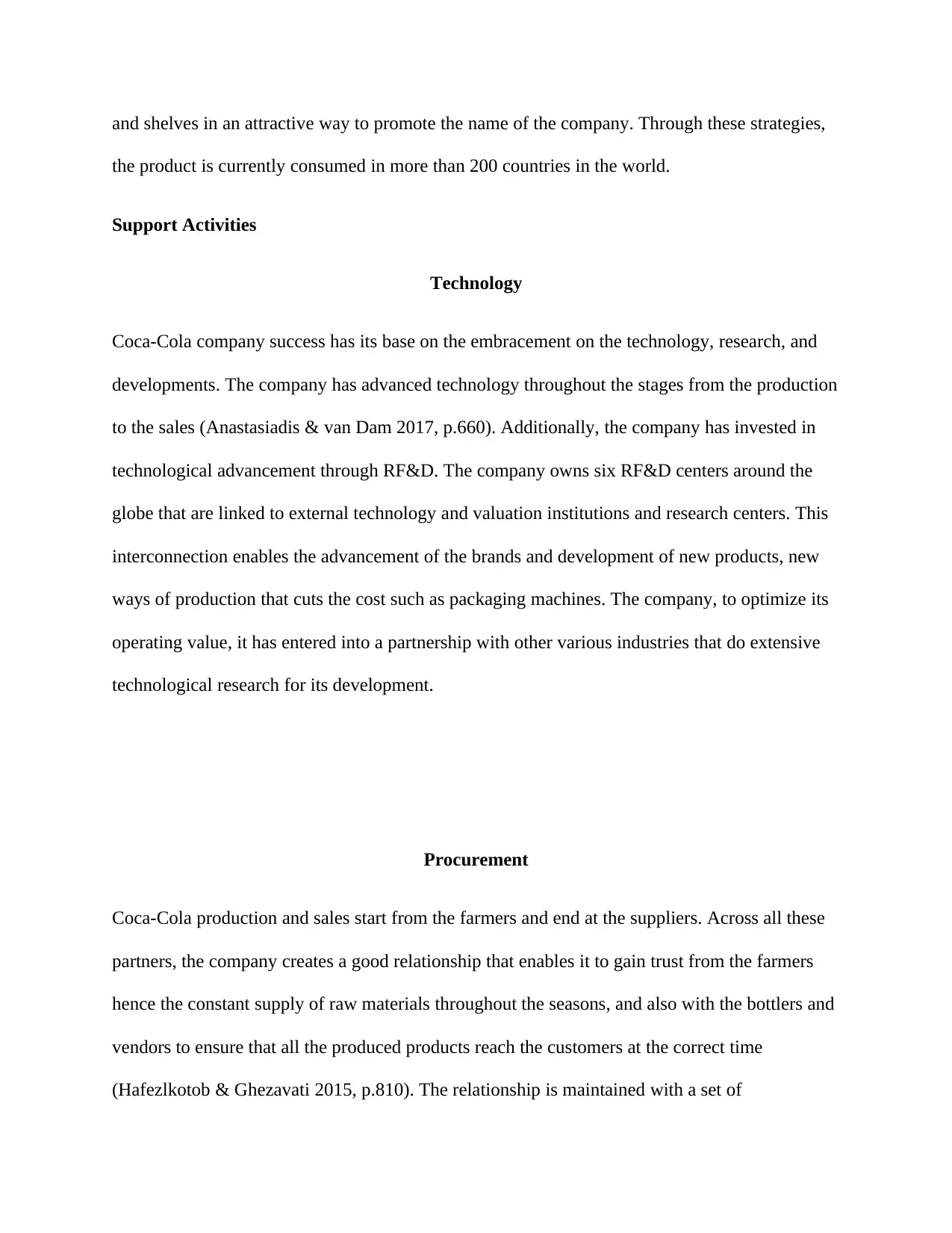
and shelves in an attractive way to promote the name of the company. Through these strategies,
the product is currently consumed in more than 200 countries in the world.
Support Activities
Technology
Coca-Cola company success has its base on the embracement on the technology, research, and
developments. The company has advanced technology throughout the stages from the production
to the sales (Anastasiadis & van Dam 2017, p.660). Additionally, the company has invested in
technological advancement through RF&D. The company owns six RF&D centers around the
globe that are linked to external technology and valuation institutions and research centers. This
interconnection enables the advancement of the brands and development of new products, new
ways of production that cuts the cost such as packaging machines. The company, to optimize its
operating value, it has entered into a partnership with other various industries that do extensive
technological research for its development.
Procurement
Coca-Cola production and sales start from the farmers and end at the suppliers. Across all these
partners, the company creates a good relationship that enables it to gain trust from the farmers
hence the constant supply of raw materials throughout the seasons, and also with the bottlers and
vendors to ensure that all the produced products reach the customers at the correct time
(Hafezlkotob & Ghezavati 2015, p.810). The relationship is maintained with a set of
the product is currently consumed in more than 200 countries in the world.
Support Activities
Technology
Coca-Cola company success has its base on the embracement on the technology, research, and
developments. The company has advanced technology throughout the stages from the production
to the sales (Anastasiadis & van Dam 2017, p.660). Additionally, the company has invested in
technological advancement through RF&D. The company owns six RF&D centers around the
globe that are linked to external technology and valuation institutions and research centers. This
interconnection enables the advancement of the brands and development of new products, new
ways of production that cuts the cost such as packaging machines. The company, to optimize its
operating value, it has entered into a partnership with other various industries that do extensive
technological research for its development.
Procurement
Coca-Cola production and sales start from the farmers and end at the suppliers. Across all these
partners, the company creates a good relationship that enables it to gain trust from the farmers
hence the constant supply of raw materials throughout the seasons, and also with the bottlers and
vendors to ensure that all the produced products reach the customers at the correct time
(Hafezlkotob & Ghezavati 2015, p.810). The relationship is maintained with a set of
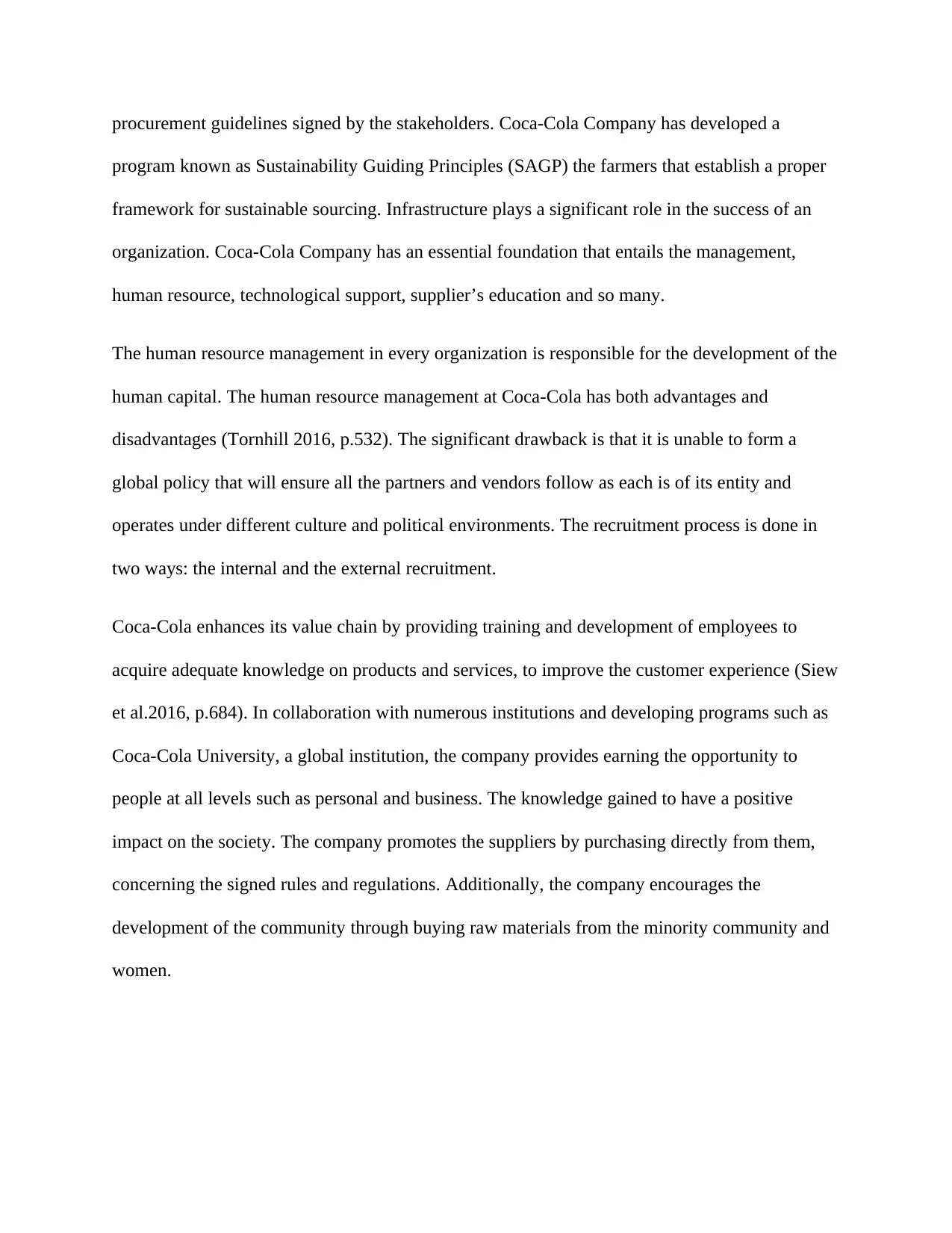
procurement guidelines signed by the stakeholders. Coca-Cola Company has developed a
program known as Sustainability Guiding Principles (SAGP) the farmers that establish a proper
framework for sustainable sourcing. Infrastructure plays a significant role in the success of an
organization. Coca-Cola Company has an essential foundation that entails the management,
human resource, technological support, supplier’s education and so many.
The human resource management in every organization is responsible for the development of the
human capital. The human resource management at Coca-Cola has both advantages and
disadvantages (Tornhill 2016, p.532). The significant drawback is that it is unable to form a
global policy that will ensure all the partners and vendors follow as each is of its entity and
operates under different culture and political environments. The recruitment process is done in
two ways: the internal and the external recruitment.
Coca-Cola enhances its value chain by providing training and development of employees to
acquire adequate knowledge on products and services, to improve the customer experience (Siew
et al.2016, p.684). In collaboration with numerous institutions and developing programs such as
Coca-Cola University, a global institution, the company provides earning the opportunity to
people at all levels such as personal and business. The knowledge gained to have a positive
impact on the society. The company promotes the suppliers by purchasing directly from them,
concerning the signed rules and regulations. Additionally, the company encourages the
development of the community through buying raw materials from the minority community and
women.
program known as Sustainability Guiding Principles (SAGP) the farmers that establish a proper
framework for sustainable sourcing. Infrastructure plays a significant role in the success of an
organization. Coca-Cola Company has an essential foundation that entails the management,
human resource, technological support, supplier’s education and so many.
The human resource management in every organization is responsible for the development of the
human capital. The human resource management at Coca-Cola has both advantages and
disadvantages (Tornhill 2016, p.532). The significant drawback is that it is unable to form a
global policy that will ensure all the partners and vendors follow as each is of its entity and
operates under different culture and political environments. The recruitment process is done in
two ways: the internal and the external recruitment.
Coca-Cola enhances its value chain by providing training and development of employees to
acquire adequate knowledge on products and services, to improve the customer experience (Siew
et al.2016, p.684). In collaboration with numerous institutions and developing programs such as
Coca-Cola University, a global institution, the company provides earning the opportunity to
people at all levels such as personal and business. The knowledge gained to have a positive
impact on the society. The company promotes the suppliers by purchasing directly from them,
concerning the signed rules and regulations. Additionally, the company encourages the
development of the community through buying raw materials from the minority community and
women.
⊘ This is a preview!⊘
Do you want full access?
Subscribe today to unlock all pages.

Trusted by 1+ million students worldwide
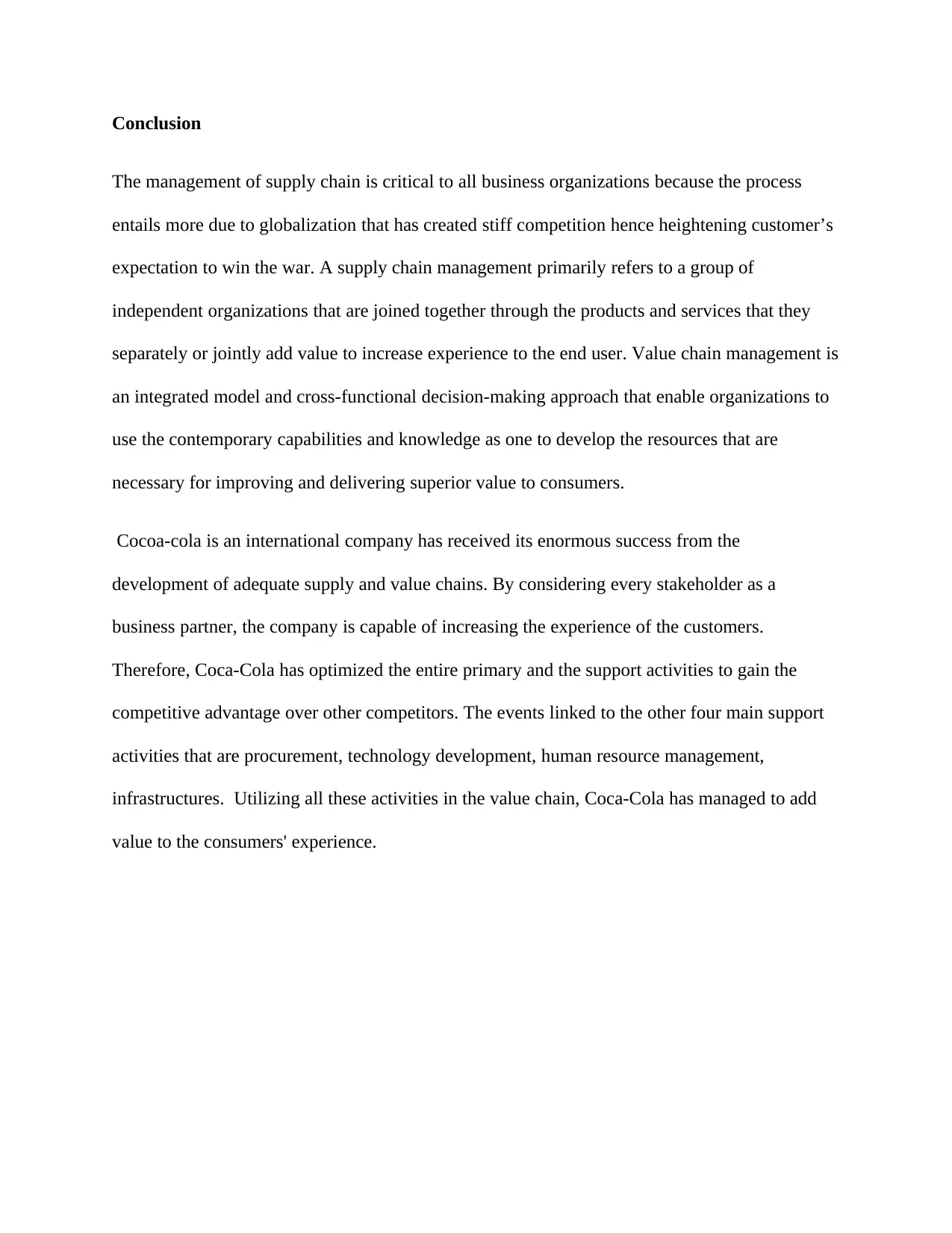
Conclusion
The management of supply chain is critical to all business organizations because the process
entails more due to globalization that has created stiff competition hence heightening customer’s
expectation to win the war. A supply chain management primarily refers to a group of
independent organizations that are joined together through the products and services that they
separately or jointly add value to increase experience to the end user. Value chain management is
an integrated model and cross-functional decision-making approach that enable organizations to
use the contemporary capabilities and knowledge as one to develop the resources that are
necessary for improving and delivering superior value to consumers.
Cocoa-cola is an international company has received its enormous success from the
development of adequate supply and value chains. By considering every stakeholder as a
business partner, the company is capable of increasing the experience of the customers.
Therefore, Coca-Cola has optimized the entire primary and the support activities to gain the
competitive advantage over other competitors. The events linked to the other four main support
activities that are procurement, technology development, human resource management,
infrastructures. Utilizing all these activities in the value chain, Coca-Cola has managed to add
value to the consumers' experience.
The management of supply chain is critical to all business organizations because the process
entails more due to globalization that has created stiff competition hence heightening customer’s
expectation to win the war. A supply chain management primarily refers to a group of
independent organizations that are joined together through the products and services that they
separately or jointly add value to increase experience to the end user. Value chain management is
an integrated model and cross-functional decision-making approach that enable organizations to
use the contemporary capabilities and knowledge as one to develop the resources that are
necessary for improving and delivering superior value to consumers.
Cocoa-cola is an international company has received its enormous success from the
development of adequate supply and value chains. By considering every stakeholder as a
business partner, the company is capable of increasing the experience of the customers.
Therefore, Coca-Cola has optimized the entire primary and the support activities to gain the
competitive advantage over other competitors. The events linked to the other four main support
activities that are procurement, technology development, human resource management,
infrastructures. Utilizing all these activities in the value chain, Coca-Cola has managed to add
value to the consumers' experience.
Paraphrase This Document
Need a fresh take? Get an instant paraphrase of this document with our AI Paraphraser
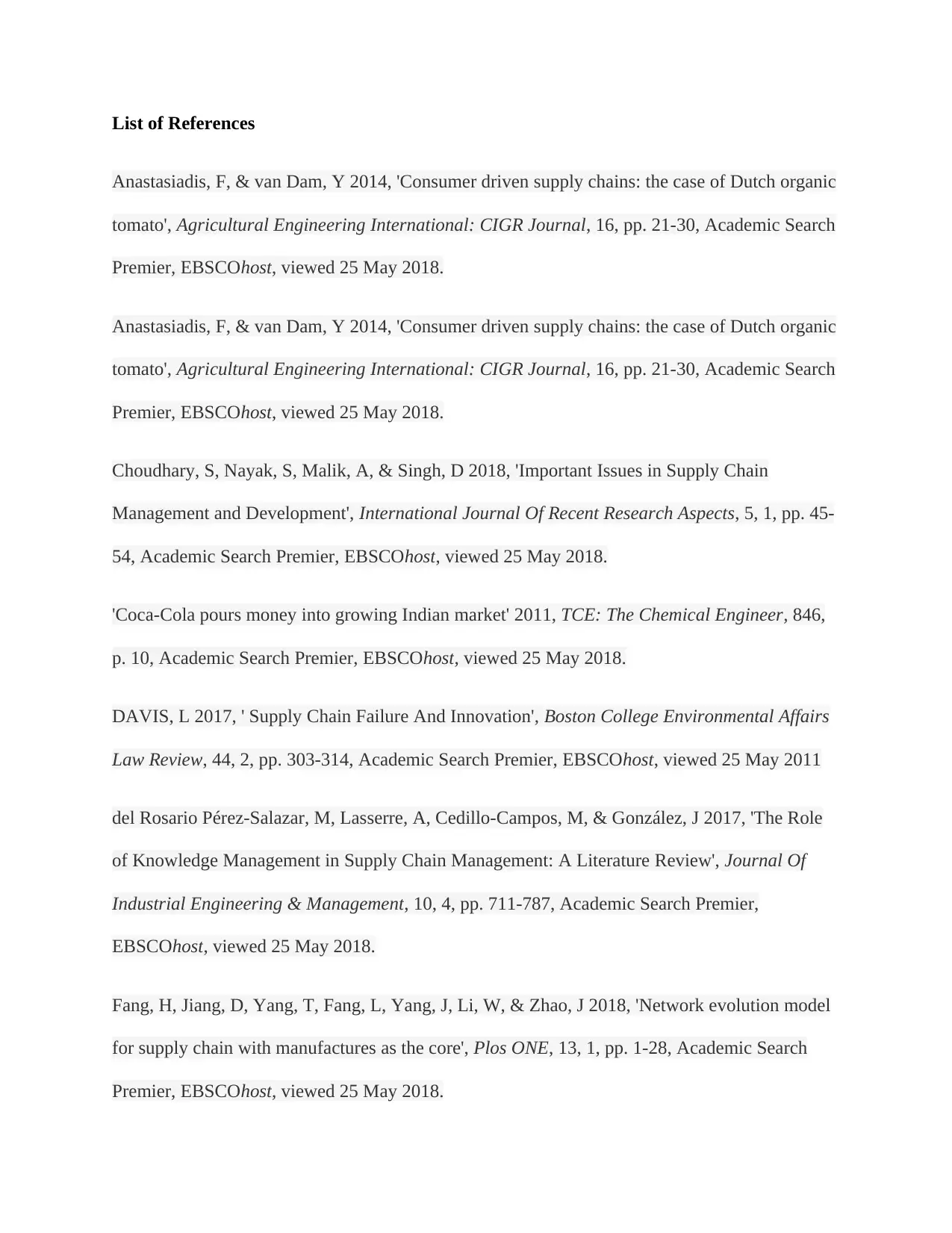
List of References
Anastasiadis, F, & van Dam, Y 2014, 'Consumer driven supply chains: the case of Dutch organic
tomato', Agricultural Engineering International: CIGR Journal, 16, pp. 21-30, Academic Search
Premier, EBSCOhost, viewed 25 May 2018.
Anastasiadis, F, & van Dam, Y 2014, 'Consumer driven supply chains: the case of Dutch organic
tomato', Agricultural Engineering International: CIGR Journal, 16, pp. 21-30, Academic Search
Premier, EBSCOhost, viewed 25 May 2018.
Choudhary, S, Nayak, S, Malik, A, & Singh, D 2018, 'Important Issues in Supply Chain
Management and Development', International Journal Of Recent Research Aspects, 5, 1, pp. 45-
54, Academic Search Premier, EBSCOhost, viewed 25 May 2018.
'Coca-Cola pours money into growing Indian market' 2011, TCE: The Chemical Engineer, 846,
p. 10, Academic Search Premier, EBSCOhost, viewed 25 May 2018.
DAVIS, L 2017, ' Supply Chain Failure And Innovation', Boston College Environmental Affairs
Law Review, 44, 2, pp. 303-314, Academic Search Premier, EBSCOhost, viewed 25 May 2011
del Rosario Pérez-Salazar, M, Lasserre, A, Cedillo-Campos, M, & González, J 2017, 'The Role
of Knowledge Management in Supply Chain Management: A Literature Review', Journal Of
Industrial Engineering & Management, 10, 4, pp. 711-787, Academic Search Premier,
EBSCOhost, viewed 25 May 2018.
Fang, H, Jiang, D, Yang, T, Fang, L, Yang, J, Li, W, & Zhao, J 2018, 'Network evolution model
for supply chain with manufactures as the core', Plos ONE, 13, 1, pp. 1-28, Academic Search
Premier, EBSCOhost, viewed 25 May 2018.
Anastasiadis, F, & van Dam, Y 2014, 'Consumer driven supply chains: the case of Dutch organic
tomato', Agricultural Engineering International: CIGR Journal, 16, pp. 21-30, Academic Search
Premier, EBSCOhost, viewed 25 May 2018.
Anastasiadis, F, & van Dam, Y 2014, 'Consumer driven supply chains: the case of Dutch organic
tomato', Agricultural Engineering International: CIGR Journal, 16, pp. 21-30, Academic Search
Premier, EBSCOhost, viewed 25 May 2018.
Choudhary, S, Nayak, S, Malik, A, & Singh, D 2018, 'Important Issues in Supply Chain
Management and Development', International Journal Of Recent Research Aspects, 5, 1, pp. 45-
54, Academic Search Premier, EBSCOhost, viewed 25 May 2018.
'Coca-Cola pours money into growing Indian market' 2011, TCE: The Chemical Engineer, 846,
p. 10, Academic Search Premier, EBSCOhost, viewed 25 May 2018.
DAVIS, L 2017, ' Supply Chain Failure And Innovation', Boston College Environmental Affairs
Law Review, 44, 2, pp. 303-314, Academic Search Premier, EBSCOhost, viewed 25 May 2011
del Rosario Pérez-Salazar, M, Lasserre, A, Cedillo-Campos, M, & González, J 2017, 'The Role
of Knowledge Management in Supply Chain Management: A Literature Review', Journal Of
Industrial Engineering & Management, 10, 4, pp. 711-787, Academic Search Premier,
EBSCOhost, viewed 25 May 2018.
Fang, H, Jiang, D, Yang, T, Fang, L, Yang, J, Li, W, & Zhao, J 2018, 'Network evolution model
for supply chain with manufactures as the core', Plos ONE, 13, 1, pp. 1-28, Academic Search
Premier, EBSCOhost, viewed 25 May 2018.
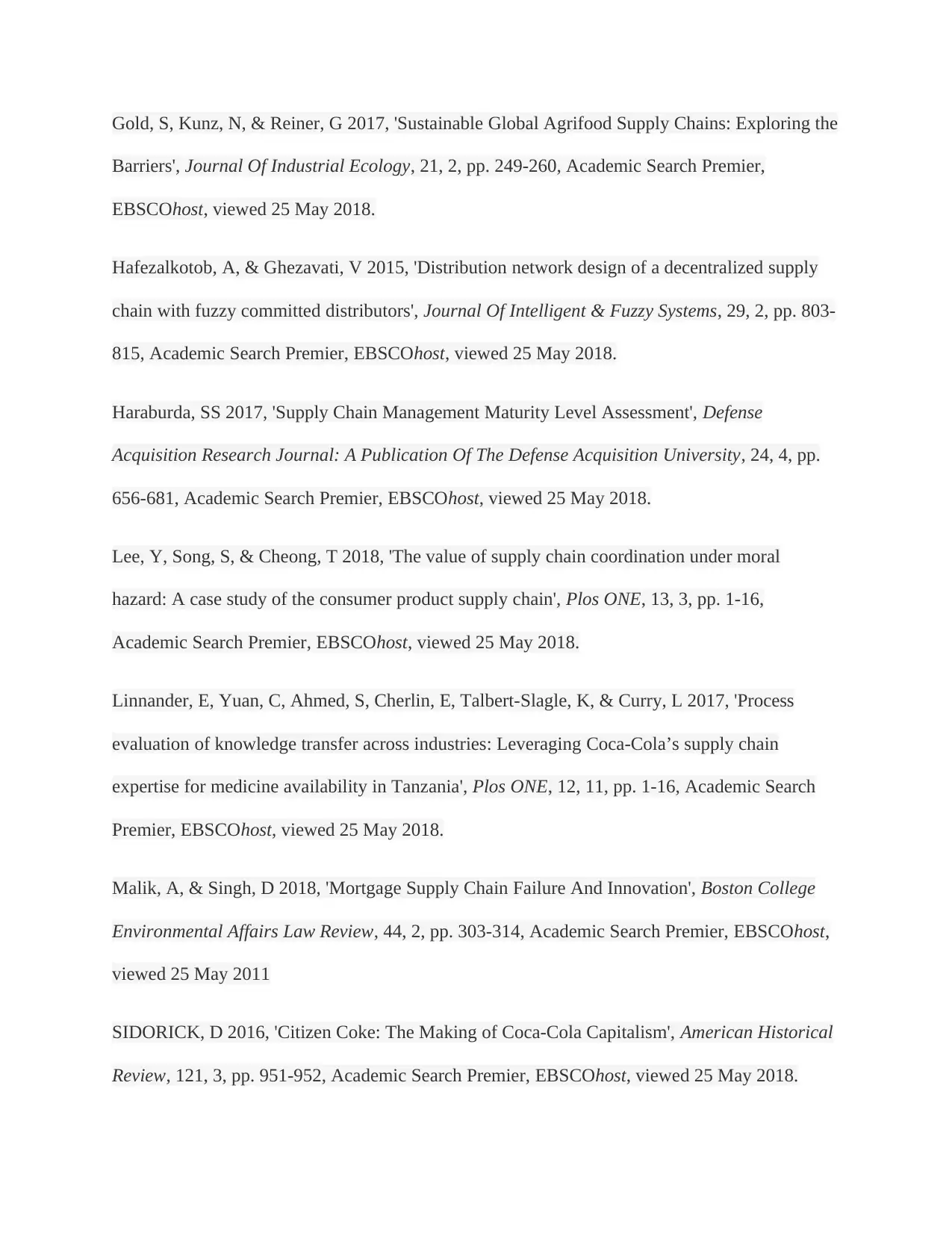
Gold, S, Kunz, N, & Reiner, G 2017, 'Sustainable Global Agrifood Supply Chains: Exploring the
Barriers', Journal Of Industrial Ecology, 21, 2, pp. 249-260, Academic Search Premier,
EBSCOhost, viewed 25 May 2018.
Hafezalkotob, A, & Ghezavati, V 2015, 'Distribution network design of a decentralized supply
chain with fuzzy committed distributors', Journal Of Intelligent & Fuzzy Systems, 29, 2, pp. 803-
815, Academic Search Premier, EBSCOhost, viewed 25 May 2018.
Haraburda, SS 2017, 'Supply Chain Management Maturity Level Assessment', Defense
Acquisition Research Journal: A Publication Of The Defense Acquisition University, 24, 4, pp.
656-681, Academic Search Premier, EBSCOhost, viewed 25 May 2018.
Lee, Y, Song, S, & Cheong, T 2018, 'The value of supply chain coordination under moral
hazard: A case study of the consumer product supply chain', Plos ONE, 13, 3, pp. 1-16,
Academic Search Premier, EBSCOhost, viewed 25 May 2018.
Linnander, E, Yuan, C, Ahmed, S, Cherlin, E, Talbert-Slagle, K, & Curry, L 2017, 'Process
evaluation of knowledge transfer across industries: Leveraging Coca-Cola’s supply chain
expertise for medicine availability in Tanzania', Plos ONE, 12, 11, pp. 1-16, Academic Search
Premier, EBSCOhost, viewed 25 May 2018.
Malik, A, & Singh, D 2018, 'Mortgage Supply Chain Failure And Innovation', Boston College
Environmental Affairs Law Review, 44, 2, pp. 303-314, Academic Search Premier, EBSCOhost,
viewed 25 May 2011
SIDORICK, D 2016, 'Citizen Coke: The Making of Coca-Cola Capitalism', American Historical
Review, 121, 3, pp. 951-952, Academic Search Premier, EBSCOhost, viewed 25 May 2018.
Barriers', Journal Of Industrial Ecology, 21, 2, pp. 249-260, Academic Search Premier,
EBSCOhost, viewed 25 May 2018.
Hafezalkotob, A, & Ghezavati, V 2015, 'Distribution network design of a decentralized supply
chain with fuzzy committed distributors', Journal Of Intelligent & Fuzzy Systems, 29, 2, pp. 803-
815, Academic Search Premier, EBSCOhost, viewed 25 May 2018.
Haraburda, SS 2017, 'Supply Chain Management Maturity Level Assessment', Defense
Acquisition Research Journal: A Publication Of The Defense Acquisition University, 24, 4, pp.
656-681, Academic Search Premier, EBSCOhost, viewed 25 May 2018.
Lee, Y, Song, S, & Cheong, T 2018, 'The value of supply chain coordination under moral
hazard: A case study of the consumer product supply chain', Plos ONE, 13, 3, pp. 1-16,
Academic Search Premier, EBSCOhost, viewed 25 May 2018.
Linnander, E, Yuan, C, Ahmed, S, Cherlin, E, Talbert-Slagle, K, & Curry, L 2017, 'Process
evaluation of knowledge transfer across industries: Leveraging Coca-Cola’s supply chain
expertise for medicine availability in Tanzania', Plos ONE, 12, 11, pp. 1-16, Academic Search
Premier, EBSCOhost, viewed 25 May 2018.
Malik, A, & Singh, D 2018, 'Mortgage Supply Chain Failure And Innovation', Boston College
Environmental Affairs Law Review, 44, 2, pp. 303-314, Academic Search Premier, EBSCOhost,
viewed 25 May 2011
SIDORICK, D 2016, 'Citizen Coke: The Making of Coca-Cola Capitalism', American Historical
Review, 121, 3, pp. 951-952, Academic Search Premier, EBSCOhost, viewed 25 May 2018.
⊘ This is a preview!⊘
Do you want full access?
Subscribe today to unlock all pages.

Trusted by 1+ million students worldwide
1 out of 13
Related Documents
Your All-in-One AI-Powered Toolkit for Academic Success.
+13062052269
info@desklib.com
Available 24*7 on WhatsApp / Email
![[object Object]](/_next/static/media/star-bottom.7253800d.svg)
Unlock your academic potential
Copyright © 2020–2025 A2Z Services. All Rights Reserved. Developed and managed by ZUCOL.





